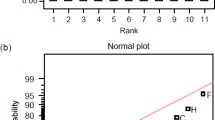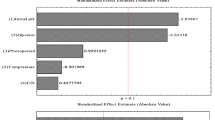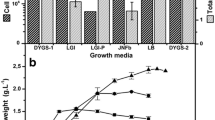Abstract
Submerged culture experiments were conducted in three phases to determine the optimal medium for rapidly producing conidia of the fungal bioherbicide Gloeocercospora sorghi. In phase I, 18 crude carbon sources were evaluated to determine which would support sporulation. Under the conditions tested, butter bean and lima bean brines (1.5–4.6 mS/cm) provided best conidiation. In phase II, a fractional-factorial design was utilized to screen 76 different medium adjuncts in combination with butter bean brine for improved sporulation. d-Mannitol and carboxymethylcellulose (CMC) were the only acceptable factors that resulted in a significant improvement. In phase III, a central composite design with response surface methodology was used to optimize concentrations of these critical factors. The model predicted optimal sporulation in a medium composed of 2.69 mS/cm butter bean brine +0.043 M d-mannitol +0.37% w/v CMC with an expected titer of 1.51×107 conidia/ml. Actual mean titer attained with the model-derived medium was 1.91×107 conidia/ml. Optimal sporulation occurred at 25.5°C in this medium and conidia remained viable up to 2.71 days when stored at 12°C. No significant difference was observed in virulence of conidia produced on agar vs washed conidia produced in the model-derived (liquid) medium.




Similar content being viewed by others
References
Bendixen L (1986) Corn (Zea mays) yield in relationship to johnsongrass (Sorghum halepense) population. Weed Sci 34:449–451
Box G, Draper N (1987) Introduction to response surface methodology. In: Empirical model-building and response surfaces. Wiley, New York, pp 1–19
Chen H (1996) Optimizing the concentration of carbon, nitrogen and phosphorus in a citric acid fermentation with response surface method. Food Biotechnol 10:13–27
Chiang M-Y, Leonard K, Van Dyke C (1989) Bipolaris halepense: a new species from Sorghum halepense (johnsongrass). Mycologia 81:532–538
Chiang M-Y, Van Dyke C, Leonard K (1989) Evaluation of endemic foliar fungi for potential biological control of johnsongrass (Sorghum halepense): screening and host range tests. Plant Dis 73:459–464
Churchill B (1982) Mass production of microorganisms for biological control. In: Charudattan R, Walker L (eds) Biological control of weeds with plant pathogens. Wiley, New York, pp 139–156
De O Souza M, Roberto I, Milagres A (1999) Solid-state fermentation for xylanase production by Thermoascus aurantiacus using response surface methodology. Appl Microbiol Biotechnol 52:768–772
Embuscado M, Marks J, BeMiller J (1994) Bacterial cellulose: optimization of cellulose production by Acetobacter xylinum through response surface methodology. Food Hydrocolloids 8:419–430
Forrester N, Geenup L, Tuart L (1975) Seasonal abundance of sorghum midge. Cotton Newslett 17:8–12
Holm L, Plucknett D, Pancho J, Herberger J (1977) Sorghum halepense (L.) Pers. In: The world’s worst weeds: distribution and biology. University Press of Hawaii, Honolulu, pp 54–61
Jackson M, Slininger P (1993) Submerged culture conidial germination and conidiation of the bioherbicide Colletotrichum truncatum are influenced by the amino acid composition of the medium. J Ind Microbiol 12:417–422
Krishna S, Chowdary G (2000) Optimization of simultaneous saccharification and fermentation for the production of ethanol from lignocellulosic biomass. J Agric Food Chem 48:1971–1976
Lekha P, Chand N, Lonsane B (1994) Computerized study of interactions among factors and their optimization through response surface methodology for the production of tannin acyl hydrolase by Aspergillus niger PKL 104 under solid state fermentation. Bioprocess Eng 11:7–15
McDaniel L, Bailey E, Ethiraj S, Andrews H (1976) Application of response surface optimization techniques to polyene macrolide fermentation studies in shake flasks. Dev Ind Microbiol 17:91–98
McWhorter C (1989) History, biology, and control of johnsongrass. Rev Weed Sci 4:85–121
Mitchell J (1988) Gibbago trianthemae, a recently described hyphomycete with bioherbicide potential for control of horse purslane (Trianthema portulacastrum). Plant Dis 72:354–355
Mitchell J (1993a) Potential of Colletotrichum graminicola and Gloeocercospora sorghi as biological herbicides for control of johnsongrass. J Trends Agric Sci 1:31–36
Mitchell J (1993b) Influence of temperature and wetness duration on johnsongrass control with Colletotrichum graminicola and Gloeocercospora sorghi. J Trends Agric Sci 1:37–44
Mortensen K (1988) The potential of an endemic fungus, Colletotrichum gloeosporioides, for the biological control of round-leaved mallow (Malva pusilla) and velvetleaf (Abutilon theophrasti). Weed Sci 36:473–478
Mountzouris K, Gilmour J, Rastall R (1999) A study of dextran production from maltodextrin by cell suspensions of Gluconobacter oxydans NCIB 4943. J Appl Microbiol 87:546–556
Rayachhetry M, Blakeslee G and R Charudattan (1996) Susceptibility of Melaleuca quinquenervia to Botryosphaeria ribis, a potential biological control agent. Plant Dis 80:145–150
Sanchez J, Perez J, Camacho F, Sevilla J, Grima E (1996) Optimization of light and temperature for growing Chlorella sp. using response surface methodology. Biotechnol Tech 10:329–334
Saval S, Pablos L, Sanchez S (1993) Optimization of a culture medium for streptomycin production using response-surface methodology. Bioresour Technol 43:19–25
Sen R, Swaminathan T (1997) Application of response surface methodology to evaluate the optimum environmental conditions for the enhanced production of surfactin. Appl Microbiol Biotechnol 47:358–363
Smith R Jr (1982) Integration of microbial herbicides with existing pest management programs. In: Charudattan R, Walker L (eds) Biological control of weeds with plant pathogens. Wiley, New York, pp 189–206
Strobel R, Sullivan G (1999) Experimental design for improvement of fermentations. In: Demain A, Davies J (eds) Manual of industrial microbiology and biotechnology. ASM Press, Washington, D.C., pp 80–93
Templeton G (1982) Status of weed control with plant pathogens. In: Charudattan R, Walker L (eds) Biological control of weeds with plant pathogens. Wiley, New York, pp 29–44
Williams C, Hayes R (1984) Johnsongrass (Sorghum halepense) competition in soybeans (Glycine max). Weed Sci 32:498–501
Winder R, Van Dyke C (1990) The pathogenicity, virulence, and biocontrol potential of two Bipolaris species on johnsongrass (Sorghum halepense). Weed Sci 38:89–94
Author information
Authors and Affiliations
Corresponding author
Rights and permissions
About this article
Cite this article
Mitchell, J.K., Njalamimba-Bertsch, M., Bradford, N.R. et al. Development of a submerged-liquid sporulation medium for the johnsongrass bioherbicide Gloeocercospora sorghi . J IND MICROBIOL BIOTECHNOL 30, 599–605 (2003). https://doi.org/10.1007/s10295-003-0088-3
Received:
Accepted:
Published:
Issue Date:
DOI: https://doi.org/10.1007/s10295-003-0088-3




